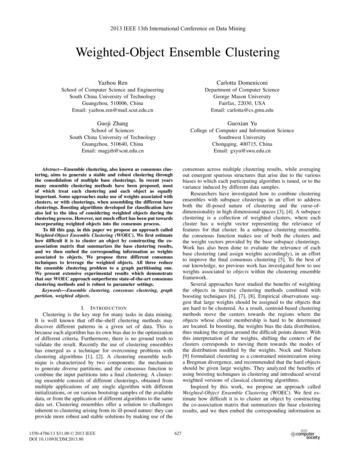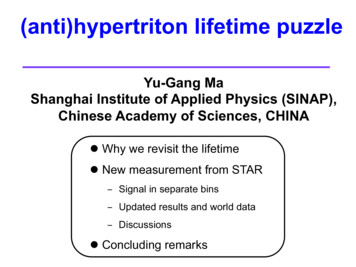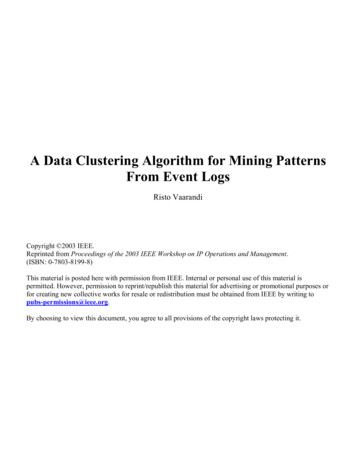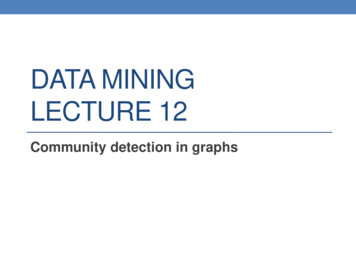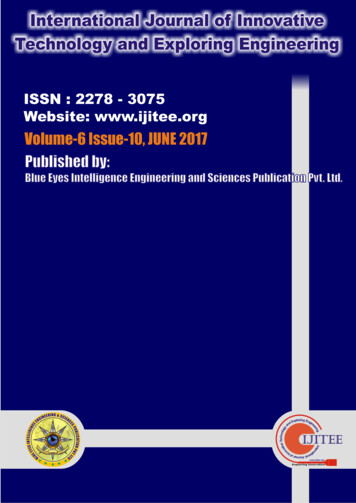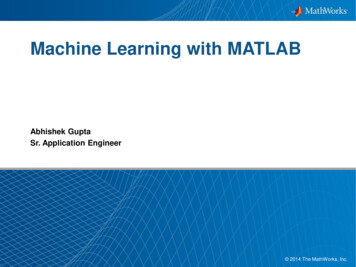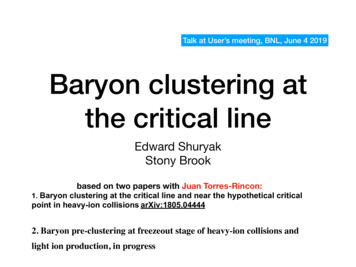
Transcription
Talk at User’s meeting, BNL, June 4 2019Baryon clustering atthe critical lineEdward ShuryakStony Brookbased on two papers with Juan Torres-Rincon:1. Baryon clustering at the critical line and near the hypothetical criticalpoint in heavy-ion collisions arXiv:1805.044442. Baryon pre-clustering at freezeout stage of heavy-ion collisions andlight ion production, in progress
At this meeting there is no need to do introduction to why do the Beam Energy Scanm 0 MeVM. A. Stephanov, K. Ra jagopal and E. V. Shuryak, Phys. Rev. Lett. 81, 4816 (1998) [hep-ph/9806219].but perhaps some words about why nucleon clustering?@L-2UVDT 10 MeVrp100The nuclear forces areextremely well tuned:two subsequentcancellations(i) sigma vs omega(attraction versus repulsion)and (ii) kinetic vs potentialenergiesresult insmall binding (0-16 MeV)from light to heavy nuclei231With or without QCD critical point,50.01we expect sigma mesonspectral densityrstrongly modified by 2UVD@MeVDm 0 MeV1004002400mymy3001 300200200w @Mmsrpms700T 100T MeV10 MeV50050060035mp0.016100100fp004mpT @MeVD10 0-450100150200250300rsfp0 100200200 250 300400300500600350w @M700 400T 150 MeVFIG. 4: (color online) The meson screening masses, the quarkmass and the chiral order parameter, 0 f , are sh@L-2UVDtemperature T at µ 0 MeV (left panel), and vs. quark chemical potential µ at T 10 MeV (right panel).multi-neutron systems are all unbound5100The dominant channel a ecting the sigma spectraltral functions. These e ects of chiral symmetry rrtionfunction is the decay into two pions, 0 ! , which isagree qualitativelywith other studies, e.g. [60p2possible for ! 2m . This process leads to a strong in- 1 mesonic spectral functions3were studied1at finite teSpectral Functions for the Quark-Meson ModelPhase Diagram(2),Rfromthe FunctionaltureRenormalizationwithin an O(N ) modelGroup,using optimizedperturcrease of the imaginary part of(!) at ! & 275 MeV,4Nils Strodthoff, Lorenz von Smekal, n Wambachbefore the zero-crossingof thereal (2014)part at !no.3, 0.01The right column of Fig. 5 shows the sigma an340 MeV. At external energies larger than 2m the0spectralfunction at a fixed temperature of T 1! channel opens up but yields only small contribursanddi erentvalues of the quark chemical potentitions compared to the decay into two pions. The process -410@M0to pointson400a horizontalin wthe!can only occur at external energies larger than 0 responding100200300500600line 700diagram near the critical endpoint. We note tha2m , i.e. beyond 1 GeV, which are not shown in Fig. 5.T 200 MeVT 250MeV arising frto the pion spectralfunctionWhen going to higher temperatures the process @L-2tributions@L-2UVDUVD00process ! are negligible at such low tempe ! , which describes the scattering of an o -shell
µ m asv in electrodynamics.slete fromequilibrationmaynot webedovalidforonmN There@µ V @ Vµ is the sameatathe scanindetail,focusoneso lled “criticalNmodes.slowdown”phenomenon,due to ofwhichassumptionstrengthof the vectorfield Fµ omega are thus wherethreeAbelianfields,fieldDiracnucleons, vectorant finding: a stronggrowthof kurtosisthe tingcompleteequilibrationmaybe valid forcertainVµ is thesigmasame asmesonin electrodynamics.There with atV@µµ V and@ scalar, interactingistributionmid-rapidity,at the lowestcollisionen-mesonsermore,on nearthe ofT,µB phasediagramof nothadroniccritical modes.smallaredistances.that thesetwoomegaterms nearlythus three Notefields, furtherDirac nucleons, nvariantway.Theirmasseshere are two typesofcriticalphenomena:mesonssigmainteracting shallowwithFurthermore, on the T, µB phase diagram of hadronicµ and scalarcanceleachVother,leavingusmesonwith e,whichwouldbeasecondorderlineWhile the specificof themultieach other in relativistically invariant way. Their massesmattercriticalthereareenhancementtwo types of criticalphenomena:neutral)tential,V 100toMbeeVan m /10, see Fig.1 Note furtherare consideredinput.Nis(i) theremainline,whichwouldsecondorderTheline resultingarticlefluctuationsthegoal beofa rquarksbemajormassless;that theare selectedThecouplingresulting staticpotential isnot to fit the binary scat(of O(4) universality class) if quarks be massless;ram,one ondordercriticalpointatcertering phases andg 2deuteronbinding,as done for all other(ii) the hypothetical second order critical point at cer2gg!2!2 mmgmranto those.Inthispaperwefocusontheclusterµc ,leadof Isinguniversalityclass.Thesearchforit,mrtain Tc , µc , of Ising universality class. The search for it,Ṽ (r) Ṽ (r) potentials,e e but eefromr! rthe fit to(2)phenomenological(2) nuclear4 r4 r4 r4 ced fluctuations as proposed in Refs [1, 2], ismatter in the mean field approximation.currently performedat RHIC,viainthefactbeamoccurenergy scan.etailbelow,significantclusteringshouldThe coupling values selected by Serot and Walecka [4]y performed at RHIC, via the beam energy scan.Consideringtheselectedcase of infinitehomogeneousmatterThecouplingvaluesby Serotand Walecka[4] oftoward itslowest energies, and even to use STAR deareuetotheusualnuclearforces.d its lowest energies,evento mode,use STARdensity n and ignoringbetweentector inanda fixedtargetwhich isdecurrentlyareunder 2 correlations 2 the nucleons,wemodified it Whilewedo notdiscussthispaperfromthe STARn Thea fixedtargetway.mode,is currentlyunderone get themean 2 , genergy g2 267.12potential 195.9(3)!2 2mNmmmdata fromthe scanfreezeoutin detail, wetemperaturedo focus on oneimpor- 2 155MeVdowntokineticofN !chilebit to2we do nottantdiscussinthispapertheSTARg 267.1,g on!n is stronger,gg! dominatingaryonsTf in100M eV we, maycomparedtoNote that the m!2couplingthusatm2Nmthe scandetail,do appearfocus onlargeoneimporcorrespondtoNhPi ()( )(4)distributionnearmid-rapidity,at thelowest collision en22small distances. Note furtherthatthesetwotermsnearlymeannuclearpotential 50MeV.Butthebinarypo2mm!ding: a strong ergies.growth of kurtosis of the yshallow po- atNotethat the ! coupling is stronger, thus multition near mid-rapidity, at the lowest collision entential, V 100 M eV mN /10, see Fig.1 Note furthersmallNote further that these two terms nearlybinaryparticle fluctuations remain the major goal of thispro- distances.that the coupling are selected not to fit the binary scat100 other, leaving us with a relatively shallowgram, one needs to study also other phenomenacancelwhich eachispotentialswellpo- known that 12 C, 16 Otering phases and deuteron binding, as done for all othercan lead enhancementto those. In this paperwe multifocus on the clusterthe specific criticalof thestrong alpha-particle correlabut seefromFig.1the fit Noteto nucleartential,Vphenomenological 100 M eV potentials, mN tion.Asweare consistent with few-alphfluctuations remain the major goal of this promatter in the mean field ail below, significant clustering should in factthatoccurthe couplingConsidering the case of infinite homogeneous matter ofdensation [5].ne needs to studyalsootherphenomenawhichdue to the usual nuclear forces.tering phasesbinding,betweenas doneall otherdensityandn anddeuteronignoring correlationsthe fornucleons,to those. In thisThepaperwefocusontheclustertemperatures of the hadronic phase, rangingfromone get the meanpotential butenergyphenomenologicalpotentials,from the fit to nuclearTc 155M eV downinteraction.to kinetic freezeouttemperature of -100aryons due to theirattractiveAs weII. SEMICLASSICALmatterng2g!2baryons Tf 100 M eV , may appear large comparedto in the mean field approximation.effectiveelow, significantclusteringshouldinfactoccurhP i )( 2)(4)TEMPERthe caseof( infinitematterofmean nuclear potential 50 M eV . But the binaryConsideringpo2m2 homogeneousm!he usual nuclear forces.sigma massdensity-200n and ignoring correlations between the nucleons,A. New version of sememperatures of the hadronic phase, ranging fromone get the mean potential energyis 285MeVtempe5 M eV down to kinetic freezeout temperature of-300ng2g!2Tf 100 M eV , may appear large compared tohP i ( )( 2)(4)Semiclassicalapproximatuclear potential 50 M eV . But the binary po2m2m!both in quantum mechaniV (MeV)!-4000.00.51.01.52.0r(fm)FIG. 1: The e ective nuclear potentials (MeV), in the vacuum (black solid line) and a modified one at the freezeoutconditions (blue dashed line).ory. Standard textbooks ofstart with Bohr-Sommerfeldsemiclassical Wentzel-Krameimation for the wave functiosuch methods beyond the ontidimensional with separableficult. Alsop already the firstterm, 1/ p(x) is not correcsingularity at the turning po
µ m asv in electrodynamics.slete fromequilibrationmaynot webedovalidforonmN There@µ V @ Vµ is the sameatathe scanindetail,focusoneso lled “criticalNmodes.slowdown”phenomenon,due to ofwhichassumptionstrengthof the vectorfield Fµ omega are thus wherethreeAbelianfields,fieldDiracnucleons, vectorant finding: a stronggrowthof kurtosisthe tingcompleteequilibrationmaybe valid forcertainVµ is thesigmasame asmesonin electrodynamics.There with atV@µµ V and@ scalar, interactingistributionmid-rapidity,at the lowestcollisionen-mesonsermore,on nearthe ofT,µB phasediagramof nothadroniccritical modes.smallaredistances.that thesetwoomegaterms nearlythus three Notefields, furtherDirac nucleons, nvariantway.Theirmasseshere are two typesofcriticalphenomena:mesonssigmainteracting shallowwithFurthermore, on the T, µB phase diagram of hadronicµ and scalarcanceleachVother,leavingusmesonwith e,whichwouldbeasecondorderlineWhile the specificof themultieach other in relativistically invariant way. Their massesmattercriticalthereareenhancementtwo types of criticalphenomena:neutral)tential,V 100toMbeeVan m /10, see Fig.1 Note furtherare consideredinput.Nis(i) theremainline,whichwouldsecondorderTheline resultingarticlefluctuationsthegoal beofa rquarksbemajormassless;that theare selectedThecouplingresulting staticpotential isnot to fit the binary scat(of O(4) universality class) if quarks be massless;ram,one ondordercriticalpointatcertering phases andg 2deuteronbinding,as done for all other(ii) the hypothetical second order critical point at cer2gg!2!2 mmgmranto those.Inthispaperwefocusontheclusterµc ,leadof Isinguniversalityclass.Thesearchforit,mrtain Tc , µc , of Ising universality class. The search for it,Ṽ (r) Ṽ (r) potentials,e e but eefromr! rthe fit to(2)phenomenological(2) nuclear4 r4 r4 r4 ced fluctuations as proposed in Refs [1, 2], ismatter in the mean field approximation.currently performedat RHIC,viainthefactbeamoccurenergy scan.etailbelow,significantclusteringshouldThe coupling values selected by Serot and Walecka [4]y performed at RHIC, via the beam energy scan.Consideringtheselectedcase of infinitehomogeneousmatterThecouplingvaluesby Serotand Walecka[4] oftoward itslowest energies, and even to use STAR deareuetotheusualnuclearforces.d its lowest energies,evento mode,use STARdensity n and ignoringbetweentector inanda fixedtargetwhich isdecurrentlyareunder 2 correlations 2 the nucleons,wemodified it Whilewedo notdiscussthispaperfromthe STARn Thea fixedtargetway.mode,is currentlyunderone get themean 2 , genergy g2 267.12potential 195.9(3)!2 2mNmmmdata fromthe scanfreezeoutin detail, wetemperaturedo focus on oneimpor- 2 155MeVdowntokineticofN !chilebit to2we do nottantdiscussinthispapertheSTARg 267.1,g on!n is stronger,gg! dominatingaryonsTf in100M eV we, maycomparedtoNote that the m!2couplingthusatm2Nmthe scandetail,do appearfocus onlargeoneimporcorrespondtoNhPi ()( )(4)distributionnearmid-rapidity,at thelowest collision en22small distances. Note furtherthatthesetwotermsnearlymeannuclearpotential 50MeV.Butthebinarypo2mm!ding: a strong ergies.growth of kurtosis of the yshallow po- atNotethat the ! coupling is stronger, thus multition near mid-rapidity, at the lowest collision entential, V 100 M eV mN /10, see Fig.1 Note furthersmallNote further that these two terms nearlybinaryparticle fluctuations remain the major goal of thispro- distances.that the coupling are selected not to fit the binary scat100 other, leaving us with a relatively shallowgram, one needs to study also other phenomenacancelwhich eachispotentialswellpo- known that 12 C, 16 Otering phases and deuteron binding, as done for all othercan lead enhancementto those. In this paperwe multifocus on the clusterthe specific criticalof thestrong alpha-particle correlabut seefromFig.1the fit Noteto nucleartential,Vphenomenological 100 M eV potentials, mN tion.Asweare consistent with few-alphfluctuations remain the major goal of this promatter in the mean field ail below, significant clustering should in factthatoccurthe couplingConsidering the case of infinite homogeneous matter ofdensation [5].ne needs to studyalsootherphenomenawhichdue to the usual nuclear forces.tering phasesbinding,betweenas doneall otherdensityandn anddeuteronignoring correlationsthe fornucleons,to those. In thisThepaperwefocusontheclustertemperatures of the hadronic phase, rangingfromone get the meanpotential butenergyphenomenologicalpotentials,from the fit to nuclearTc 155M eV downinteraction.to kinetic freezeouttemperature of -100aryons due to theirattractiveAs weII. SEMICLASSICALmatterng2g!2baryons Tf 100 M eV , may appear large comparedto in the mean field approximation.effectiveelow, significantclusteringshouldinfactoccurhP i )( 2)(4)TEMPERthe caseof( infinitematterofmean nuclear potential 50 M eV . But the binaryConsideringpo2m2 homogeneousm!he usual nuclear forces.sigma massdensity-200n and ignoring correlations between the nucleons,A. New version of sememperatures of the hadronic phase, ranging fromone get the mean potential energyis 285MeVtempe5 M eV down to kinetic freezeout temperature of-300ng2g!2Tf 100 M eV , may appear large compared tohP i ( )( 2)(4)Semiclassicalapproximatuclear potential 50 M eV . But the binary po2m2m!both in quantum mechani!V (MeV)But, at the freezeout ofheavy ion collisions, weareclose to critical Tc,and this delicatebalance canbe strongly modified:a decrease of m(sigma)is expected-4000.00.51.01.52.0r(fm)FIG. 1: The e ective nuclear potentials (MeV), in the vacuum (black solid line) and a modified one at the freezeoutconditions (blue dashed line).ory. Standard textbooks ofstart with Bohr-Sommerfeldsemiclassical Wentzel-Krameimation for the wave functiosuch methods beyond the ontidimensional with separableficult. Alsop already the firstterm, 1/ p(x) is not correcsingularity at the turning po
Our first paper was based on general study of clustering:globular clusters in Galaxies,kinetics near liquid-gas transitionsnow production etcusing rather simple tool,classical Molecular dynamics(excellent way to study out-of equilibrium situations)Our second paper was about quantum effectsin equilibrium clustering:(i) semiclassical “flucton” method at finite T;(ii) QM with hyper spherical coordinates for He4;(iii) path integral Monte-Carlo ;So, whether the particular effects we discussdo or do not happen in real life,we worked out interesting methodical tools
l known, see e.g.[3], one can also apply theseSince in this work we deal only with quantum mechann statistical mechanics. For this one needsical limit of vanishing temperature T ! 0, the Matsubme into its Euclidean version i Semiclassicalt definedara timeapproachgoes to infinity.toIt clusters:is clear then that the particle3ith circumference tot . Such periodicshould spend a divergently long time near the turningfluctonpathsat whichnonzeroTinwhenequilibriumgauge theory). Thisis so wellknownthat densityanysemiclassical point,description ofthe groundisstatewave casefuncn as thelatticeMatsubaratime,andthethext ! 0, the location ofreferences are not needed.tions. It has been shown in the above mentioned papershowpath TurbinerintegralhigherorderAnother interestingusage of thisis develthesemiclassicalmaximumof correctionsV , insee quantumFig.1. Evidently,such classiantum systemis relatedto anicscorrespond to the asymptotic expansion of solutions toopment of a novel semiclassical theory. Its main ideam with istemperaturepath withinfinite period is the onewith zero energythat in certain conditions the path integral is domSchr ’odinger calequation.Unlikeworksinmultimentionalcasesinated by minimal action (classical) path,called “fluc- WKBAt finite temperatures the path integral is modified, 0. byTheidea is that such classical path withton”. The idea was introduced in [7]. (Also it was inbut it can stillEbe dominatedcertainbasicclassical eWKB,thispaths.Theyshould:T / .(9)And correctionsaredownFeynmandiagramszeroenergyE by0 ”climbsup the hill”to its maximumapproach works for multidimensional and QFT settings.(i) be still periodic, starting and ending at the desigIt also leads to systematic perturbative series based onatproblemsx point0. x ;nated observationWhereforseveralcalculated up to 3 loopsFeynman diagrams, with clearrules for each order.he groundSystematicstateapplicationof thequantumsystemisof this method at zero temper(ii) have a specific time period in , the “Matsubaraature ( ! 1) for aofnumberofpathquantumimpliesmechanical thatovered. Periodicitythetime”, related to the temperature by .problems has been developed in [9–11]. The andshownone endpoint xi xf x0 .In Fig.2 we provide two sketches explaining how theseto be in exact agreement with asymptotics of the groundpaths look like.xtobject ofstateourstudy Allisdetailsthethediagonalwave functions.reader can owthisthese references: some of these results for anharmonice densitymatrix,givingprobability methodfor works for the harmonic oscillator, with the Euoscillatorwe will usein the on I xoordinate value x0 (or a particular field conẋxV (x)S d ,(4)paths( x) in QFT) influctonthis ensemble220 T22ExturnZ x( shouldwhichhave correct period) xx0 are chosen to have m where three mechanical units! 1. The dot indicate derivative over the Euclidean0time it, and the circle at the integral reminds usSE [x( )]/ that it is defined on a Matsubara circle. Note that theof the potential in the action is inverted, which isx(0) x0xturn signthe consequence of i2 1 in the kinetic term.x0path which: (i) passes through /2The flucton is a classical0some arbitrary point x0 ; and (ii) is periodic with thexperiod . Because in Euclidean time the potential isinverted, the particle is “sliding” from the maximum0at x 0 to 1. Most applications before were atT 0, 1 and the slide was always started fromxturnx0the maximum, at zero energy.Now, at nonzero T , such slides also starts with zero2velocity but from a certain “turning point” xturn andproceed to x0 . The turning point, by symmetry, shouldbe separated from the x0 be the time equal to half periodxturn0x0/2. For any one-dimensional motion there is no need tousethe Newton equation of motion. Expressingvelocity /2 0tfrom energy conservation on the path, this condition canxbe put into thetgeneral formZ x0ndxp .(5)FIG. 2: Two sketches explaining properties of the flucton22(V (x) E)/mxturn NDx( )e.(10) nto account all (closed) trajectories startingT is defined via theat x . Here the weight) latexit sha1 base64 "(null)" (null) /latexit tion ZFIG. 1: The sketch of the inverted potential V versus coordinate x. Flucton is the classical trajectory starting andending at the same initial point x0 . At non-zero temperature it goes through the turning point xt , see text. At zerotemperature x coincides with the location of the maximum,x 0. m dxd V (x) .2 d rd definition of the density matrix in termsstates ni with energy E , the sum overes a set classicalof decreasingexponentialspaths. The upper one shows the (flipped) potentialVX(x) versus its coordinate. The needed path starts fromFor oscillator, withV usx /2,findit is easyto findthe turn- paths explicitly. They, of course,Letthefluctonarbitrary observation point2 x (redEndot), goes uphill, turns ing point by solvingx0 , ) back at the turningn (xpoint0 ) x e (blue dot),.and returns to x (11)satisfy thex second order classical Equation Of Motionduring the required period /T . The lower plot illustratethe samen path as a function of Euclidean time defined on aE V (x) (6)(EOM),but2 in, the one-dimensionalcase it is much easier“Matsubara circle” with circumference .and calculatetothe integralfor theenergyperioduse theconservation, at E 0of large or low temperature T , in the ex xAt T 0 quantumthe dominantterm systems are in their ground states, arccosh p(7)pand therefore studies of the density matrix are related to22Ed20turn0turn2turn0
and both at 0 and it returns to the t toT 6 0the nice review [? ].ult.A.AlsoalreadytheWKBclassicalpointx first. Now, substitutingitcorrectionto the action one findsp(the first time ever)testing the flucton method at finite Tthatm, 1/ p(x) is not correct and containsan unphysical 1 A. LetFluctonsfor anharmonicoscillatorat problem,T 6 (9)0S[x first( )] non-trivialx tanhusnowproceedtothean2gularity at the turning point.020f luc10-5x20 tanh0P(x0 )anharmonic oscillator,and the defineddensity matrixbyis therefore Gaussian at any temperatureet us now proceedI tothenon-trivial problem, an first1022( ).ẋxgP(x) e(10)armonicoscillator,bySE methods definedd few-body x4 physics. Analyticofat (11)finiteThis reproducestheresultobtainedbyFeynman[12]via222 10IexplicitcalculationofGaussianpath integral. As it haptemperature22ẋfor any xpensGaussian gpath 4integral, this semiclassicalSE usedd in x example.(11)formulaeis inpreviousfact exact.The tacticstheisnoteasy 10222-4-2024to implement:in particularly,theperiodcondition(4)the efinitionofthedensitymatrixIII. SEMICLASSICAL THEORY AT ednumericallyfortactics used in the previous example is not easy0Xeach value ofthex0 .A. Furthermore,2 usingE/Tenergymplement:inparticularly,period(4) (2)Fluctonsthefor anharmonicoscillatorat T 6 0 consericondition-5P(x) (x) e0i0vationnaturallyto to(x)of the forpath,ningtheleadsenergyE needsberepresentationsolved numericallyLet ius now proceed to the first non-trivial problem, ntionalx( ).value of the x0 . Furthermore, using energy conser dthaton leadsnaturallyto (x)S andrepresentationthe (11)path, and d their x of. functions,ggesttofindallstates22 wave2-20Pconventional(x0 )way toexpSEproblem[xf luctonthesimplestsolvetheis: ( )]erthanx( ).en do weighting withthefactor.The tacticsused Boltzmannin the previous exampleis not easyNeedless-25 FIG. 3: Top panel: Density matrixto implement:in particularly,the concludedperiod condition llythesecondorderEOM,say, itsolveis rarelypossibletothisdefinitiondefining theenergyEuseneeds tobe solvednumerically startingfor in prac-30 monic oscillator with the couplingsimplestwaytosolvetheis:each valueof problemthe x . Furthermore,using energy conserfromthevationobservationx0 approachbutfrom the(pointsontheplot)e. Innotthisworkwewillfollowthistwice: 0T 11, calculatedleadsnaturallyto point(x) representationof the path,via4 the definition2panel:3 DensityFIG.3:Topmatrix Pratherthanconventionalx( hemethodworksverywelltonmethod(points).Theline is b) ucleon problemin ordersectionA,with largeAftera numberofstrategies,weIVconcludedthatx0monic oscillator with the coupling gthesimplestway tonumericalsolve the problemis:locityvanishẋ 0andsolvercanreadilywave functions found numerically. ’odingernotfrom thetoobservationpointx0 butforfromtheFIG. moofsolutionsSchrequationrelative3: Toppanel:matrix P (x ) vsx foranharT 1,Densitycalculatedviathedefinitionof ((i) solve numerically the second order EOM, startingbeused;sonofthelogarithmicderivativemonic oscillator with the coupling g 1, at temperature. notItwithis easierbecausethefromthesolutionsobservationpoint tox herebutfromthe veturnT radial 1, calculatedvia the definition(1) (line) and Thethe fluc- line is bastonuppermethod(points).n,turningand inpointSec.xIVB,e ectivepanel.turning point x. It is easier because here the veton method (points). The line is based on 60 lowest statelocityvanishẋ locityvanishẋ dnumerically. Bottompanel:numerically.Compari(ii) followthe solutionforhalfperiod/2andthusfinduationin K-harmonicsmethodappliedtoHe.be used;son of the logarithmic derivative of the density matrix of thebe used;son of the logarithmic derivative of thupper panel.the locationof(ii)xfollow the1960’s,whenx( /2);0tot methodgoes backitwasappliedtosolution for half period /2 and thus find2-10-1522Ed log P(x0 )/dx0-2040000turnthe location of x0 x( /2);upper panel.e) (iii)groundstatesof ecAsapproacha culatetheactionanddouble(iii)4 calculate the corresponding action and double it, ton solution workswhen the actionis large,i.e.solutionworksbetterwhentox( accountother halfgeneralperiod.d theboundstateof inandmoreuse of it to tonbetterlocationx0 He for the/2);
urtosisof the multiplicity distribuand lower plots respectively. The solid blacki()line for l 0,xpected at lower RHIC energies, butblue dashed and brown dash-dotted lines are for l 1 and2. x[1] x[2] or hyperdistance, x[1] x[2] 2 x[3]15 as d.Theradialcoordinate,isdefinedpp [1] , [2] ,K-harmonicsappliedtoHe4(notanewmethod,is for readers interestedin s26dstedsignalinwouldbetwo-bodydecaymanyis methodicalandyetiswefoundnewwithatit )Oneinterestingpossibilityprovidedthe soforcalledartofthepaperas a contributionfrom pre-clusters.e ect bysomethingwhichtheA 4casehandare3ters,as an enhancementat low Similarin-deXX14 K-harmonics4[16],whichwe[7],describebrieflyin App.A. methodicalde222ep/pis“flucton”expectedat methodlowerRHICenergies,miclassicalso but3 t,ratioddchannels.(Wealsoremind [m] ( x[i] ocalled x[1] x[2] x[1] x[2]2 x[3]XXJacobicoordinatesfor4particlesx[3]3 x[4]p 4 otyetobserved.Inthepracticefocusesonthethe lowest,most symmet1 x[2], [2] ,0 only[9,10].Wehaveshownhow [1]aysinto4 protonsisonepresumably22x[1]p 2method[7],sop [3] K-harmonics[16],whichwedescribebrieflyinApp.A.m 1 i6 j26 [j])otherricproposedsignalwouldbe two-bodydecay [m] ( x[i] x(A1)groundstates,obtainedfrom1Dradial softhemultiplicitydistribuIn pre-clusters,the practice asoneanfocuseson the lowest,most symmetels ofenhancementat lowin4veshownhowequationforthe“hyperdistance” definedinEq.(A1)m anharmonici6 jTheradialpart of ortheLaplacianinis theseJacobicoorditmodelsmass in, suchsay p ast, ddchannels. (Weoscilalso sasumoverJacobicoordinatessquared.Webriefly x[1] x[2] x[3]3 in Eq.is rkwell, 8 0 ( )/ , anddecaysinto4 protonspresumablythewasappliedtoinis2manyand 4definedp using substitution [3]nates( ) indicateintheApp.Athederivationofthecorrespond2 3a insumover Jacobipartofthepaperisofmethodicalde- ltiplicitydistribu- We cil1Theradialpartofthe [m]in 4 xtheseJacobicoordiing Schrödinger-likeintheof 2HehereweLaplacianindicateinthe App.methodA equationthederivationof casethecorrespond22miclassical“flucton”[7],so ( einTheradialor( ) hyperdistance,( )/ , is defined as(A2)00of 4 He isSchrödinger-likeinhowthecaseherewe0 hersummaryis Wefor4thereadersinterestedmany4 0 ingonly[9,10].thathaveshownedto2andnatesi
FIG. 4: (color online) The meson screening masses, the quark mass and the chiral order parameter, 0 f , are shown vs. temperature T at µ 0MeV (left panel), and vs. quark chemical potential µ at T 10MeV (right panel). The dominant channel a ecting the sigma spectral function is the decay into two pions, 0! ,whichis possible .


